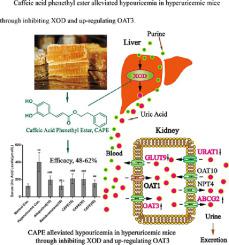Phytomedicine ( IF 6.7 ) Pub Date : 2022-06-08 , DOI: 10.1016/j.phymed.2022.154256 Tianqiao Yong 1 , Danling Liang 2 , Shaodan Chen 1 , Chun Xiao 1 , Xiong Gao 1 , Qingping Wu 1 , Yizhen Xie 1 , Longhua Huang 1 , Huiping Hu 1 , Xiangmin Li 1 , Yuancao Liu 1 , Manjun Cai 1

|
Background
: Hyperuricemia is characterized with high serum uric acids (SUAs) and directly causes suffering gout. Caffeic acid phenethyl ester (CAPE) is widely included in dietary plants and especially propolis of honey hives.
Hypothesis/Purpose
: Since CAPE exerts a property resembling a redox shuttle, the hypothesis is that it may suppress xanthine oxidase (XOD) and alleviate hyperuricemia. The aim is to unveil the hypouricemic effect of CAPE and the underlying mechanisms.
Methods
: By establishing a hyperuricemic model with potassium oxonate (PO) and hypoxanthine (HX) together, we investigated the hypouricecmic effect of CAPE. On this model, the expressions of key mRNAs and proteins, including glucose transporter 9 (GLUT9) and urate transporter 1 (URAT1), and the activity of XOD were assayed in vivo. Also, the inhibitory effect of CAPE against XOD was assayed in vitro through enzymatic activity tests and by molecular docking.
Results
: CAPE demonstrated a remarkable hypouricemic effect, which reduced the SUAs of hyperuricemic mice (401 ± 111 µmol/L) to 209 ± 56, 204 ± 65 and 154 ± 40 µmol/L (p < 0.01) at the doses of 15, 30 and 60 mg/kg respectively, depicting efficacies between 48-62% and approaching allopurinol's efficacy (52%). Serum parameters, body weights, inner organ coefficients, and H&E staining suggested that CAPE displayed no general toxicity and it alleviated the liver and kidney injuries caused by hyperuricemia. Mechanistically, CAPE decreased XOD activities significantly in vivo, presented an IC50 at 214.57 µM in in vitro and depicted a favorable binding to XOD in molecular simulation, indicating that inhibiting XOD may be an underlying mechanism of CAPE against hyperuricemia. CAPE did decreased GLUT9 protein and down-regulated URAT1 mRNA and protein. In addition, CAPE up-regulated ATP binding cassette subfamily G member 2 (ABCG2) and organic anion transporter 3 (OAT3) mRNA and proteins in comparison with that of the hyperuricemic control. All above, CAPE may alleviate hyperuricmia through inhibiting XOD, decreasing GLUT9 and URAT1 and increasing ABCG2 and OAT3.
Conclusion
: CAPE presented potent hypouricemic effect in hyperuricemic mice through inhibiting XOD activity and up-regulating OAT3. CAPE may be a promising treatment against hyperuricemia.
中文翻译:

咖啡酸苯乙酯通过抑制XOD和上调OAT3减轻高尿酸血症小鼠低尿酸血症
背景
:高尿酸血症的特点是血清尿酸(SUAs)偏高,直接导致痛风。咖啡酸苯乙酯 (CAPE) 广泛包含在膳食植物中,尤其是蜂巢的蜂胶中。
假设/目的
:由于 CAPE 具有类似于氧化还原穿梭的特性,因此假设它可以抑制黄嘌呤氧化酶 (XOD) 并缓解高尿酸血症。目的是揭示 CAPE 的降尿酸作用及其潜在机制。
方法
: 通过建立含氧酸钾 (PO) 和次黄嘌呤 (HX) 的高尿酸血症模型,我们研究了 CAPE 的低尿酸血症作用。在该模型上,在体内检测了包括葡萄糖转运蛋白 9 (GLUT9) 和尿酸盐转运蛋白 1 (URAT1) 在内的关键 mRNA 和蛋白质的表达,以及 XOD 的活性。此外,通过酶活性试验和分子对接在体外测定了 CAPE 对 XOD 的抑制作用。
结果
:CAPE 具有显着的降尿酸作用,在 15、30 的剂量下使高尿酸血症小鼠的 SUA (401 ± 111 µmol/L) 降低至 209 ± 56、204 ± 65 和 154 ± 40 µmol/L ( p < 0.01)和 60 mg/kg 分别描述了 48-62% 的功效和接近别嘌醇的功效 (52%)。血清参数、体重、内脏系数和 H&E 染色表明 CAPE 没有表现出一般毒性,它减轻了高尿酸血症引起的肝肾损伤。机制上,CAPE在体内显着降低 XOD 活性,在体外呈现214.57 µM的 IC 50并在分子模拟中描绘了与 XOD 的有利结合,表明抑制 XOD 可能是 CAPE 对抗高尿酸血症的潜在机制。CAPE 确实降低了 GLUT9 蛋白并下调了 URAT1 mRNA 和蛋白。此外,与高尿酸对照相比,CAPE 上调 ATP 结合盒亚家族 G 成员 2 (ABCG2) 和有机阴离子转运蛋白 3 (OAT3) mRNA 和蛋白质。综上所述,CAPE可能通过抑制XOD,降低GLUT9和URAT1,增加ABCG2和OAT3来缓解高尿酸血症。
结论
: CAPE 通过抑制 XOD 活性和上调 OAT3 对高尿酸血症小鼠产生有效的降尿酸作用。CAPE 可能是一种有希望的高尿酸血症治疗方法。











































 京公网安备 11010802027423号
京公网安备 11010802027423号